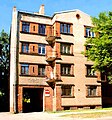Ernests Štālbergs
Ernests Jekabowitsch / Jakowlewitsch Stalbergs ( Russian Эрнест Екабович / Яковлевич Шталберг ; born September 3 . Jul / 15. September 1883 . Greg in Liepaja ; † 12. June 1958 in Riga ) was a Latvian - Russian architect and university lecturer .
Life
After attending school in Liepāja, Štālbergs studied at the Kazan Art School from 1902–1904 . In 1903 in Riga he met Helena Roerich and Nicholas Roerich . After graduating, he worked in Kazan as an assistant to the university director Karl Lyudwigowitsch Mjufke in the construction of the new university building, and he designed the steel staircase. From 1911 to 1914 he studied with LN Benois at the Art Academy in St. Petersburg and worked with WA Shchuko and IA Fomin , who brought in the most talented students for their projects. In 1911 he was involved in the planning of the Russian pavilion for the Turin World Exhibition in 1911 under the direction of WA Shchuko . In 1914, the Štālbergs received his architectural diploma. In 1914, together with IA Fomin, he built a classicist apartment building for the New Petersburg stock corporation .
After the October Revolution , Štālbergs took over the management of the performing arts department of the People's Commissariat for Education . Together with W. Mayakowski , O. Brik and N. Punin , he published the magazine Kunst der Kommune in October 1918 . He was the rector of the Wchutemas - Wchutein and headed the architecture class from 1919 to 1922.
In 1922 the Štālbergs settled in Riga. 1922–1950 he taught at the architecture faculty of the University of Riga (from 1945 as professor). 1922–1940 he built villas in Mežaparks . 1923–1926 he built the theater in Ropaži . In 1924 he built the Kurhaus in Kemmern in Jūrmala . In 1925 he designed a triumphal arch of victory and unknown soldiers . In 1927 he planned a Volkshaus , which was only partially realized in 1930. 1928–1929 he was the third president of the Latvian Architects' Association founded in 1924 (after Eižens Laube and August Reiter ). 1928-1936 he created the assembly hall of the University of Riga. In 1930 he built a row house in Riga with two bas-reliefs by Kārlis Zemdega . 1931-1935 he realized the Freedom Monument according to the exact specifications of the sculptor Kārlis Zāle . 1936-1938 he built the children's tuberculosis - sanatorium in Cesis . In 1937 he designed with Karlis Zemdega the monument Sudrabkalniņš for the 6th Riga Infantry Regiment, which the city in 1919 to attack the White Army of General Bermondt-Awaloff defended.
After the German-Soviet War , Štālbergs became an Honored Scientist of the Latvian Soviet Socialist Republic (SSR) in 1945 . 1945–1951 he was executive chairman of the Union of Architects of the Latvian SSR . From 1946–1951 he headed the Building and Architecture Institute of the Latvian Academy of Sciences , of which he had been a member since 1946. 1947–1950 he created the Riga Lenin monument with the sculptors WJ Boboljubow and WI Ingal from Leningrad .
Štālbergs' students during the Leningrad period included OL Ljalin and JA Waks and during the Latvian period Artur Reinfeld and Marta Staņa .
Honors
- Commander of the Three Star Order of the Republic of Latvia
Works
literature
- Шталберг Эрнест Екабович, архитектор (accessed March 15, 2016).
- JM Wasiljew: E. Štālbergs . In: From the history of the technique of the Latvian SSR. 5th edition, Riga 1964.
Individual evidence
- ↑ Шталберг, Эрнест Екабович. Great Soviet Encyclopedia 1969.
- ^ Lew Bukowski (Russian, accessed March 15, 2016).
- ↑ V. Apsītis: Karlis Zāle . Liesma-Verlag, Riga 1988, ISBN 5-410-00439-6 .
- ↑ Ул. Э. Дарзиня, 15, Кемери, Юрмала (accessed March 15, 2016).
Web links
| personal data | |
|---|---|
| SURNAME | Štālbergs, Ernests |
| ALTERNATIVE NAMES | Shtalbergs, Ernests; Шталберг, Эрнест Екабович / Яковлевич (Russian) |
| BRIEF DESCRIPTION | Latvian-Russian architect and university professor |
| DATE OF BIRTH | September 15, 1883 |
| PLACE OF BIRTH | Liepāja |
| DATE OF DEATH | June 12, 1958 |
| Place of death | Riga |



